Opportunity rover’s view across Botany Bay to Solander Point – her next destination – as NASA celebrates 10 Years since blastoff for Mars on July 7, 2003. The rover will climb up Solander Point because it which may harbor clay minerals indicative of a past Martian habitable environment. This pancam mosaic was assembled from raw images taken on Sol 3348 (June 24, 2013.
Credit: NASA/JPL/Cornell/ASU/Marco Di Lorenzo/Ken Kremer (kenkremer.com)[/caption]
Today, NASA’s Opportunity rover marks a magical moment celebrating 10 years since launching to Mars on July 7, 2003 and with her impending Mountain destination filling the camera’s eye view.
The now legendary robot has vastly exceeded everyone’s expectations. Back in 2003 the science team promised us a mere 90 day ‘warranty’ following the suspenseful airbag landing on Jan. 24, 2004 at Meridiani Planum.
Today is Martian Day (or Sol) 3360. That amounts to a life expectancy and exploration ‘bonus’ of more than 37 times beyond the design lifetime.
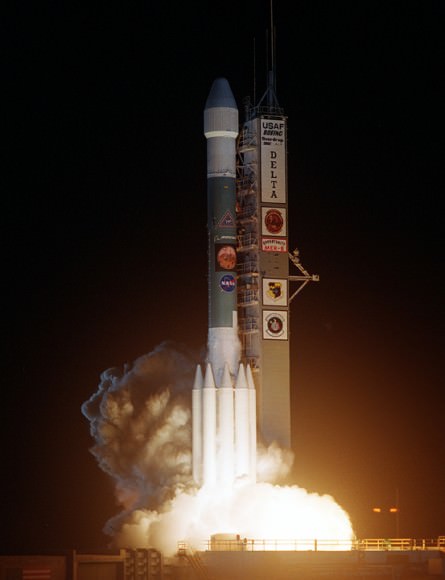
Opportunity’s twin sister Spirit blasted off three weeks earlier in June 2003 and continued functioning until 2010.
“I never thought we’d achieve nine months!” Principal Investigator Prof. Steve Squyres of Cornell University told me recently on the occasion of the rovers 9th anniversary on Mars in January 2013.
As you read this, the now decade old rover Opportunity is blazing a trail toward’s the oldest geological deposits she has ever explored – at a place called Solander Point, a raised ridge along the eroded rim of huge Endeavour Crater.
Opportunity has surpassed the halfway point in the traverse from the rim segment she has explored the past 22 months at ‘Cape York’ to her next rim segment destination at Solander.
From tip to tip, Cape York and Solander Point lie 1.2-mile (2-kilometer) apart along the western rim of Endeavour Crater. Both are raised portions of 14-mile-wide (22-kilometer-wide) Endeavour.
The rover has less than half a mile (800 meters) to go to finish the Martian dash from one rim segment to the next across an area called ‘Botany Bay’.
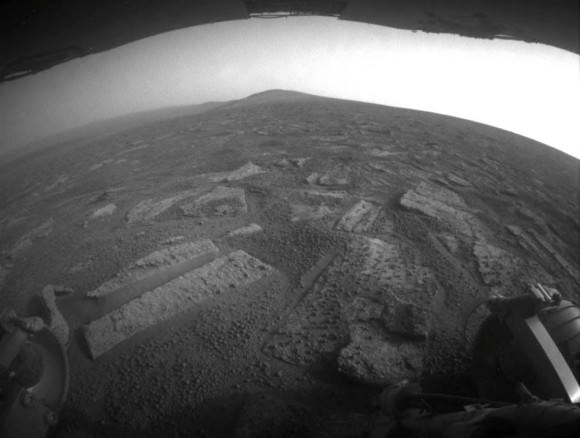
“We are making very good progress crossing ‘Botany Bay,’ said John Callas of NASA’s Jet Propulsion Laboratory, Pasadena, Calif., who is project manager for the mission now entering its 2nd decade.
The flat terrain of fractured, light-toned bedrock is devoid of treacherous dunes and is easy to drive across, almost like a highway, which simplifies the daily planning by the rovers Earthly handlers.
“The surface that Opportunity is driving across in Botany Bay is polygonally fractured outcrop that is remarkably good for driving,” said Brad Joliff, an Opportunity science team member and long-term planner at Washington University in St. Louis. “The plates of outcrop, like a tiled mosaic pavement, have a thin covering of soil, not enough to form the wind-blown ripples we’ve had to deal with during some other long treks. The outcrop plates are light-toned, and the cracks between them are filled with dark, basaltic soil and our old friends the ‘blueberries.”
The “blueberries” are hematite-rich, erosion-resistant concretions about the size of BB’s that Opportunity discovered when she first opened her eyes at her Eagle crater landing site. During the multi year crater hopping tour that ensued, the rover continued finding patches of blueberries all the way to Endeavour crater.
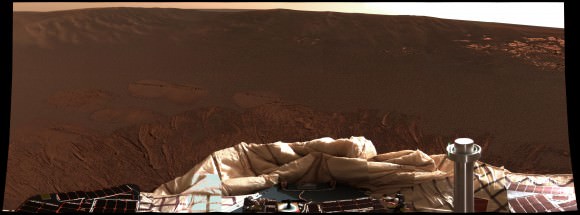
Opportunity is expected to arrive at Solander’s foothills sometime in August – before the onset of the next southern hemisphere Martian winter, her 6th altogether.
Opportunity will scale Solander to continue the science quest in search of additional evidence of habitable environments with the chemical ingredients necessary to sustain Martian microbial life.
“Right now the rover team is discussing the best way to approach and drive up Solander,” Ray Arvidson told Universe Today. Arvidson is the mission’s deputy principal scientific investigator from Washington University in St. Louis, Mo.
‘Solander Point’ offers roughly about a 10 times taller stack of geological layering compared to ‘Cape York.’
Solander also offers north facing slopes where Opportunity’s solar wings can more effectively soak up the sun’s rays to generate life giving electrical power.
The robot remains in excellent health.
The total driving distance exceeds 23 miles (37 kilometers). She has snapped over 181,000 images.
Meanwhile on the opposite side of Mars at Gale Crater, Opportunity’s younger sister rover Curiosity also discovered a habitable environment originating from a time when the Red Planet was far warmer and wetter billions of years ago.
And like Opportunity, Curiosity is also trekking towards a mountain rich in sedimentary layers, hoping to unveil the mysteries of Mars past.

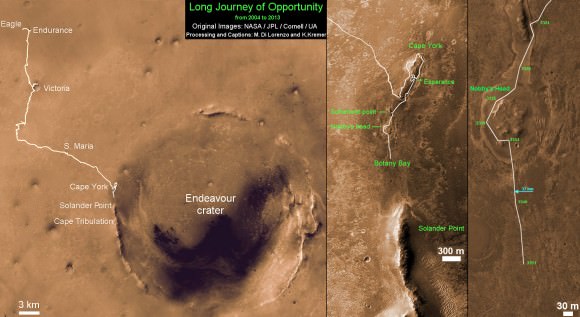
This map shows the entire path the rover has driven during more than 9 years and over 3360 Sols, or Martian days, since landing inside Eagle Crater on Jan 24, 2004 to current location heading south to Solander Point from Cape York ridge at the western rim of Endeavour Crater. Credit: NASA/JPL/Cornell/ASU/Marco Di Lorenzo/Ken Kremer

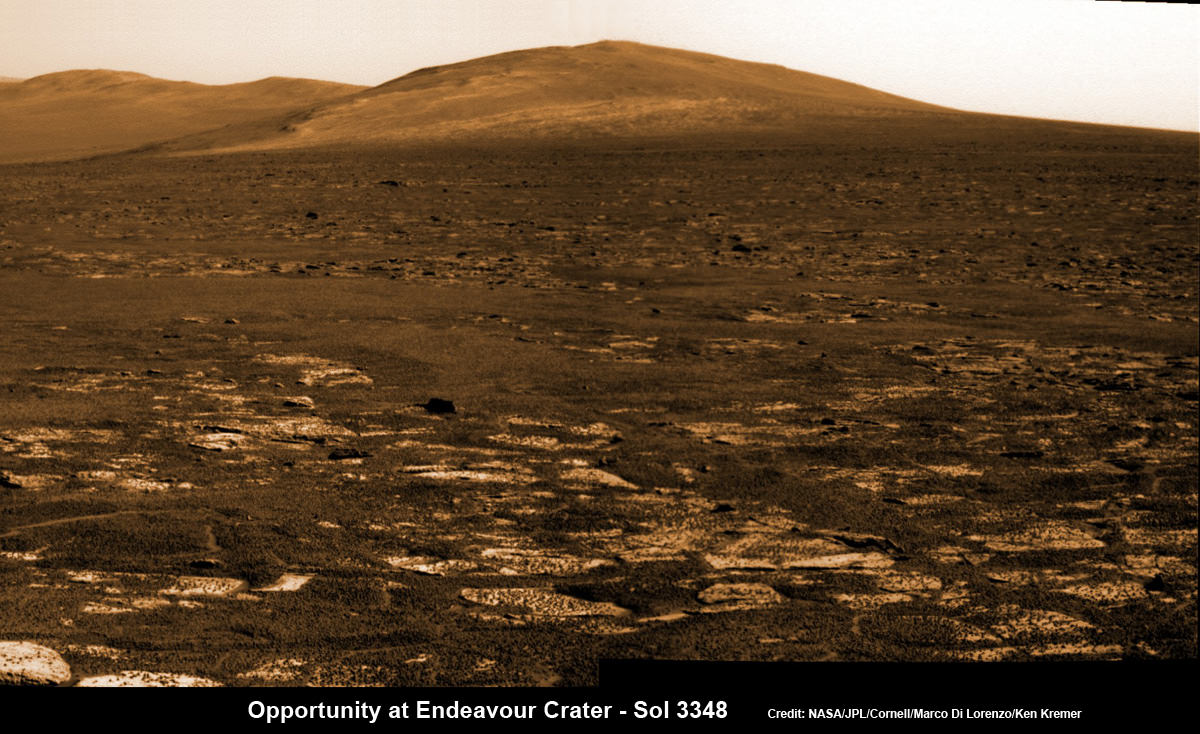
The Black Rock at the middle of the image may be a new target for Opportunity !
We really need to avoid buying into the idea that a spacecraft that’s, in fact, built to last several years, is somehow exceptional because its (much shorter) primary mission is completed. A major factor in whether a mission is extended, and how much is done, is how much additional funding it gets. The Mercury Messenger mission was tanked with twice as much fuel as it needed to complete the primary mission. The extended mission is not happening because the satellite was even better than they thought — they designed in the extra fuel. Fuel that cost plenty to get to Mercury! In many cases, where tolerances aren’t well understood, it would be imprudent to do anything but overdesign. The fact that an overdesigned spacecraft usually pulls through shouldn’t be seen as a surprise to anyone, but a statistical likelihood.
For just a moment there, I thought you were going to say something intelligent. Indeed, it is irritating when people who know better pretend that the mission was only expected to last 90 days. 90 days was the minimum it needed to last for the supplier to be paid for the rover. It was, quite literally, a warranty. And everything should outlast its warranty. That said, nobody expected it to last an entire decade and still be going strong. Nobody planned on making it 23 miles with over 180,000 photos. This is an unprecedented success.
Where you really betrayed the fact that you know nothing about what you are talking about is when you made the ludicrous claim that they would spend what would be a ton of money just to send along fuel to last 40 times the warranty period. If they’d known it would last this long, and they had to send fuel to enable it to continue, they still wouldn’t have. It would have been far too expensive. They would have sent, maybe, a year’s worth – tops. And then they’d have known exactly what the maximum mission length would be.
It’s solar powered. Unless you think they bit off a chunk of sun and packed it into a rocket, they didn’t have to send any fuel at all.
As a result, it could theoretically still be working a hundred years from now. It won’t be, but it could be.
More likely, it will break down in the next year or two. But when humans get to Mars, they might eventually go get it and repair it. Why not?
Considering those extreme conditions on Mars, 10 years of operation is an enormous success. Outstanding engineering!!!
The little rover that could.
gah! can we have a discussion and not a wrestling match?
he was pointing out that the Mercury mission was scrubbed before it’s fuel ran out.
i agree, use them until they stop responding.
10 years is a fantastic result and we should design them to last even longer. the other rover might be still working if not for some bad luck with dust during overwinter.
it really proves the efficacy of the solar panel/battery model.
tech that will only improve for future rovers.
You know what? You’re absolutely right. I completely misread his post and drew incorrect conclusions. Upon re-reading it, I see that I somehow totally misinterpreted it. My apologies to Snowshift, and my apologies to the community.
Why haven’t we built and launched a half dozen more of these?
IMHO we should have had 6-8 of these little guys scouting various places, then we take the most interesting and then send Curiosity in there with a more specialized payload of instruments.
tinyurl.com/l3cselt.